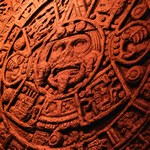Aztec New Year in Mexico Date in the current year: March 12, 2025
 The Aztec New Year (Año Nuevo Azteca), also known as the Mexica New Year (Año Nuevo Mexicano), is celebrated by some Nahua communities in Mexico on March 12. Some of the biggest and most important celebrations occur in Mexico City, Huauchinango, Naupan, Xicotepec, and Zongolica.
The Aztec New Year (Año Nuevo Azteca), also known as the Mexica New Year (Año Nuevo Mexicano), is celebrated by some Nahua communities in Mexico on March 12. Some of the biggest and most important celebrations occur in Mexico City, Huauchinango, Naupan, Xicotepec, and Zongolica.The Aztecs were a Mesoamerican culture that flourished in what is now central Mexico from the 14th to the 16th centuries; their descendants are known today as the Nahuas. They used a complex calendar system consisting of two parallel cycles: the 365-day xiuhpōhualli (agricultural calendar for “counting the days”) and the 260-day tōnalpōhualli (sacred/ritual calendar). Together, these cycles formed a 52-year calendar round; the end of each round and the beginning of a new one was marked by the New Fire Ceremony.
It is generally considered that the Aztec New Year fell on March 12 in the Gregorian calendar. However, this theory has recently been contested. Professor Rafael Tena of the National Institute of Anthropology and History calculated that the first day of the year in the Aztec calendar fell on February 13 in the old Julian calendar or February 23 in the Gregorian calendar. However, Nahua communities in Mexico continue to celebrate the Aztec New Year on March 12.
The celebration of the Aztec New Year, called Yancuic Xihuitl in Nahuatl, usually begins on the eve of the holiday, the night of March 11, just like New Year celebration in the Gregorian calendar begins on New Year’s Eve. The festivities include ceremonial dances and songs set to the beat of traditional drums. Dancers wear colorful traditional clothes and headdresses made from quetzal feathers. Their performances are mesmerizing, and they are definitely a must-see for everyone who has such an opportunity.
It is also customary to present seeds as offerings, burn ritual candles made from aromatic ocote pine resin, and set off fireworks (the firework tradition is, of course, pretty recent). The celebration lasts until the sunrise on March 12, when the new year officially begins. It ends with the burning of a flag that represents the old year and perfuming of a replacement flag. Finally, revelers welcome the new year by blowing into conch shells, just like their Aztec ancestors did.
In addition to the nighttime festivities, educational and cultural establishments across Mexico organize various events and activities dedicated to the Aztec New Year on or around March 12. They include storytelling, traditional dance performances, ceremonial seed plantings, indigenous craft fairs, food stalls, family activities, and more. These events aim to educate attendees about the rich Aztec heritage, as well as the symbolism and various traditions associated with the Aztec New Year.
The Aztec New Year is celebrated by many Nahua communities in Mexico; as we’ve already mentioned above, the biggest and most popular celebrations are held Mexico City, Huauchinango, Naupan, Xicotepec, and Zongolica. Small-scale celebrations are also organized by some Nahua communities in the United States, particularly in the Los Angeles and Houston areas.
- Category
- Cultural Observances, Folk Festivals
- Country
- Mexico
- Tags
- Aztec New Year, Mexica New Year, cultural festivals, folk festivals, holidays in Mexico